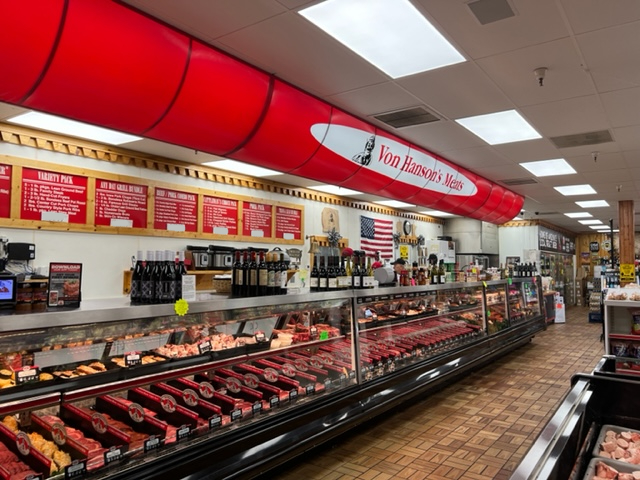Leading Reasons to Shop at Bagley Farms Meat Market Edwardsville IL for Costs Meats
Leading Reasons to Shop at Bagley Farms Meat Market Edwardsville IL for Costs Meats
Blog Article
Uncover the Art of the Butcher's Cut in a Modern Meat Market
In the ever-evolving landscape of modern meat markets, the butcher's cut has transcended its standard roots, merging olden workmanship with modern methods. bagley farms meat market edwardsville il. Today's butchers are not merely processors of meat; they are educated craftsmens who stress sustainability and moral sourcing. Their competence in picking and preparing cuts tailored to details culinary demands supplies an unmatched eating experience. Yet, what absolutely establishes the modern-day butcher apart is their capability to create a much deeper connection in between customers and the origins of their meat. Just how do these masters balance custom with technology, and what implications does this have for the future of meat consumption?
Advancement of Butchery Techniques

The mid-20th century saw butchery strategies even more improved by scientific insights into muscle mass biology and meat aging, boosting both tenderness and taste. Innovations like vacuum packaging and refrigeration extended item shelf-life, permitting butchers to diversify offerings and improve top quality control. This duration additionally marked the rise of specialized equipment, such as band saws and meat slicers, which enhanced accuracy and effectiveness in meat handling.
Electronic systems currently assist in monitoring pet provenance and maximizing cuts to fulfill details consumer preferences. Additionally, a rebirth in artisanal butchery has actually arised, blending conventional skills with contemporary understanding to provide to consumers seeking ethical and lasting meat alternatives.

Recognizing Meat Cuts

Understanding the complexities of meat cuts is vital for both butchers and consumers looking for high quality and value. Each cut originates from a various component of the pet, imparting distinct flavors, appearances, and food preparation approaches. Mastery of these distinctions not just boosts cooking experiences but likewise makes the most of the energy of each carcass. For butchers, exact cuts reflect skill and regard for the craft, making certain marginal waste and optimal return.
The key groups of meat cuts include primal, sub-primal, and retail cuts. Primal cuts, such as the loin, rib, and chuck, are the huge sections initially separated from the carcass. Butchers then damage these down further into sub-primal cuts, prior to ultimately creating retail cuts available to consumers, like ribeye or tenderloin. Each stage needs careful focus to physiological framework and muscular tissue make-up.
Comprehending muscle composition is vital; muscular tissues utilized more regularly by the pet have a tendency to be harder and are best matched for slow food preparation approaches, while less-used muscle mass, like those found in the loin, are more tender and ideal for cooking or roasting. Familiarity with these distinctions encourages customers to make educated selections, boosting their cooking undertakings.
Selecting High Quality Meat
Selecting the right meat entails greater than just choosing a visually attractive item from the screen. The art of choosing top quality meat needs a discerning eye and knowledge of details attributes that symbolize quality and excellence. Pay focus to the shade; beef must have a bright, cherry-red shade, while lamb needs to exhibit a soft pink tone, and pork a light pink. This indicates the meat is fresh and hasn't been revealed to oxygen for as well lengthy.
Second of all, think about the dig this marbling, which refers to the white streaks of fat within the muscular tissue. Appropriate marbling is an essential indication of inflammation and flavor, as it melts during food preparation, improving the meat's juiciness. Remember, greater marbling commonly correlates with superior high quality cuts, such as USDA Prime.
Texture is another essential factor; meat must feel solid to the touch, not slimed or excessively soft. In addition, be mindful of the aroma. Fresh meat needs to have a clean, neutral scent, without any kind of sour or off-putting smells.
Coupling Cuts With Food Preparation Methods
Successfully combining cuts of meat with the ideal food preparation techniques is important for achieving optimal flavor and structure. These techniques enhance the meat's natural flavors and make sure a juicy coating.
Conversely, harder cuts like brisket and chuck roast are abundant in collagen, which breaks down into jelly when cooked gradually. These cuts are suitable for braising or slow roasting, allowing the meat to tenderize over time and develop deep, complicated flavors. Cuts such as brief ribs and pork shoulder make out well with slow-cooking techniques, where prolonged cooking times change their durable appearances right into delicious dishes.
Lamb shanks and oxtail, which need right here extended food preparation to soften, are ideal prospects for cooking or sluggish simmering. These approaches coax out abundant, hearty tastes while maintaining moisture. By comprehending the one-of-a-kind attributes of each cut, cooks and home chefs alike can elevate their culinary productions, guaranteeing each recipe is both pleasing and remarkable.
The Butcher's Function Today
Navigating the advancing landscape of the modern meat market, the butcher's function today prolongs beyond simple preparation of cuts. Contemporary butchers are cooking artisans, instructors, and advocates for lasting methods.
In enhancement to crafting exact cuts, butchers currently engage straight with clients, supplying cooking recommendations and customizing options to suit specific requirements and choices. Their know-how in meat aging, marbling, and flavor profiles empowers customers to make informed choices, enhancing their cooking experiences. This customized service exemplifies the butcher's developing function as a relied on consultant in the kitchen.
Additionally, butchers are pivotal in reducing waste, making use of whole animals to create diverse items such as sausages and stocks - bagley farms meat market edwardsville il. This extensive approach not just values the pet yet additionally aligns with contemporary sustainability objectives. his response By doing this, the modern butcher personifies both tradition and development, adapting to an ever-changing market while preserving the virtuosity and stability of their craft

Conclusion
The modern butcher's craft delicately weaves typical strategies with modern-day developments, highlighting sustainable methods and honest sourcing. Mastery in recognizing diverse meat cuts and quality indications empowers butchers to provide educated referrals, aligning certain cuts with optimum food preparation methods. This competence not only boosts culinary experiences yet likewise strengthens the connection in between consumers and the origins of their food. By honoring historic methods while welcoming modern needs, the butcher's duty continues to be crucial in today's sophisticated meat market.
Report this page